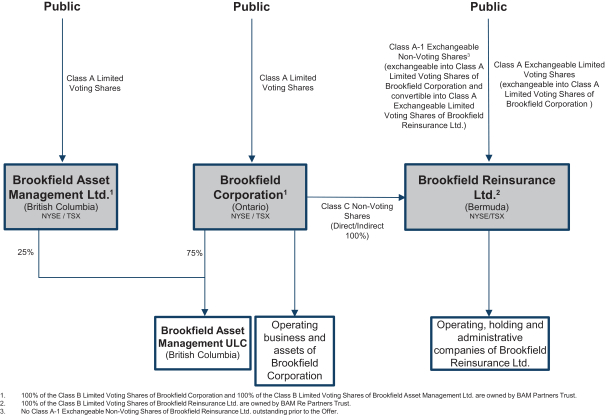(“RRSP”), registered retirement income fund (“RRIF”), registered education savings plan (“RESP”), first home savings account (“FHSA”), registered disability savings plan (“RDSP”), deferred profit sharing plan and a tax free savings account (“TFSA”) (collectively, “Registered Plans”). Provided that the class A exchangeable shares are listed on a designated stock exchange at the time the class A exchangeable shares are acquired on a conversion of class A-1 exchangeable shares for class A exchangeable shares, the class A exchangeable shares would, at such time, be a qualified investment for Registered Plans. Provided that the Brookfield Class A Shares are listed on a designated stock exchange, or that Brookfield Corporation is otherwise a “public corporation” (as defined in the Tax Act) at the time the Brookfield Class A Shares are acquired in connection with a redemption, exchange or other disposition to our company or to Brookfield Corporation, the Brookfield Class A Shares, would, at such time, be a qualified investment under the Tax Act for Registered Plans.
Notwithstanding that class A-1 exchangeable shares, class A exchangeable shares or Brookfield Class A Shares, as applicable, may be a qualified investment for a TFSA, FHSA, RDSP, RRSP, RRIF or RESP, the holder of a TFSA, FHSA or RDSP, the annuitant of an RRSP or RRIF or the subscriber of an RESP, as the case may be, would be subject to a penalty tax in respect of the class A-1 exchangeable shares, class A exchangeable shares or Brookfield Class A Shares, as applicable, if such class A-1 exchangeable shares, class A exchangeable shares or Brookfield Class A Shares, as applicable, are a “prohibited investment” for purposes of the Tax Act for such Registered Plans. Based on the current provisions of the Tax Act and the regulations thereunder, the class A-1 exchangeable shares, class A exchangeable shares and Brookfield Class A Shares, as applicable, would not be a prohibited investment for a TFSA, FHSA, RDSP, RRSP, RRIF or RESP, provided that the holder of the TFSA, FHSA or RDSP, the annuitant of the RRSP or RRIF or the subscriber of the RESP, as the case may be, (i) deals at arm’s length with our company or Brookfield Corporation, as applicable, for purposes of the Tax Act and (ii) does not have a “significant interest” (as defined in subsection 207.01(4) of the Tax Act) in our company or Brookfield Corporation, as applicable. In addition, the class A-1 exchangeable shares, class A exchangeable shares and Brookfield Class A Shares, as applicable, would not be a prohibited investment if the class A-1 exchangeable shares, class A exchangeable shares or Brookfield Class A Shares, as applicable, are “excluded property” (as defined in subsection 207.01(1) the Tax Act) for a TFSA, FHSA, RDSP, RRSP, RRIF or RESP.
Holders who hold or intend to hold the class A-1 exchangeable shares, class A exchangeable shares or Brookfield Class A Shares in a Registered Plan should consult their own tax advisers with respect to the application of these rules in their particular circumstances.
Taxation of Holders not Resident in Canada
The following portion of the summary is generally applicable to a Holder who, at all relevant times, for the purposes of the Tax Act, is not, and is not deemed to be, resident in Canada and does not use or hold (i) the Brookfield Class A Shares, (ii) the class A-1 exchangeable shares received on an exchange of Brookfield Class A Shares for class A-1 exchangeable shares pursuant to the Offer, (iii) Brookfield Class A Shares received on a redemption, exchange or other disposition of class A-1 exchangeable shares to our company or Brookfield Corporation, and (iv) class A exchangeable shares (including any class A exchangeable shares received on a conversion of class A-1 exchangeable shares), as applicable, in a business carried on in Canada (a “Non-Resident Holder”). Special rules, which are not discussed in this summary, may apply to a Non-Resident Holder that is an insurer that carries on an insurance business in Canada and elsewhere.
Exchange of Brookfield Class A Shares for Class A-1 Exchangeable Shares Pursuant to the Offer
A Non-Resident Holder will not be subject to tax under the Tax Act on any capital gain realized on the exchange of a Brookfield Class A Share for a class A-1 exchangeable share pursuant to the Offer, unless the Brookfield Class A Share constitutes taxable Canadian property of the Non-Resident Holder for purposes of the Tax Act at the time of the exchange and the Non-Resident Holder is not entitled to relief under an applicable income tax treaty or convention between Canada and the country in which the Non-Resident Holder is resident.
98

